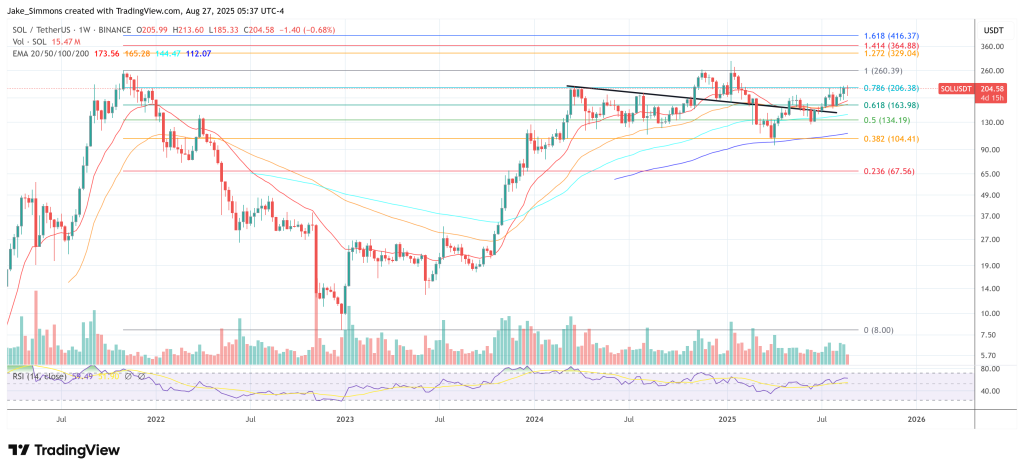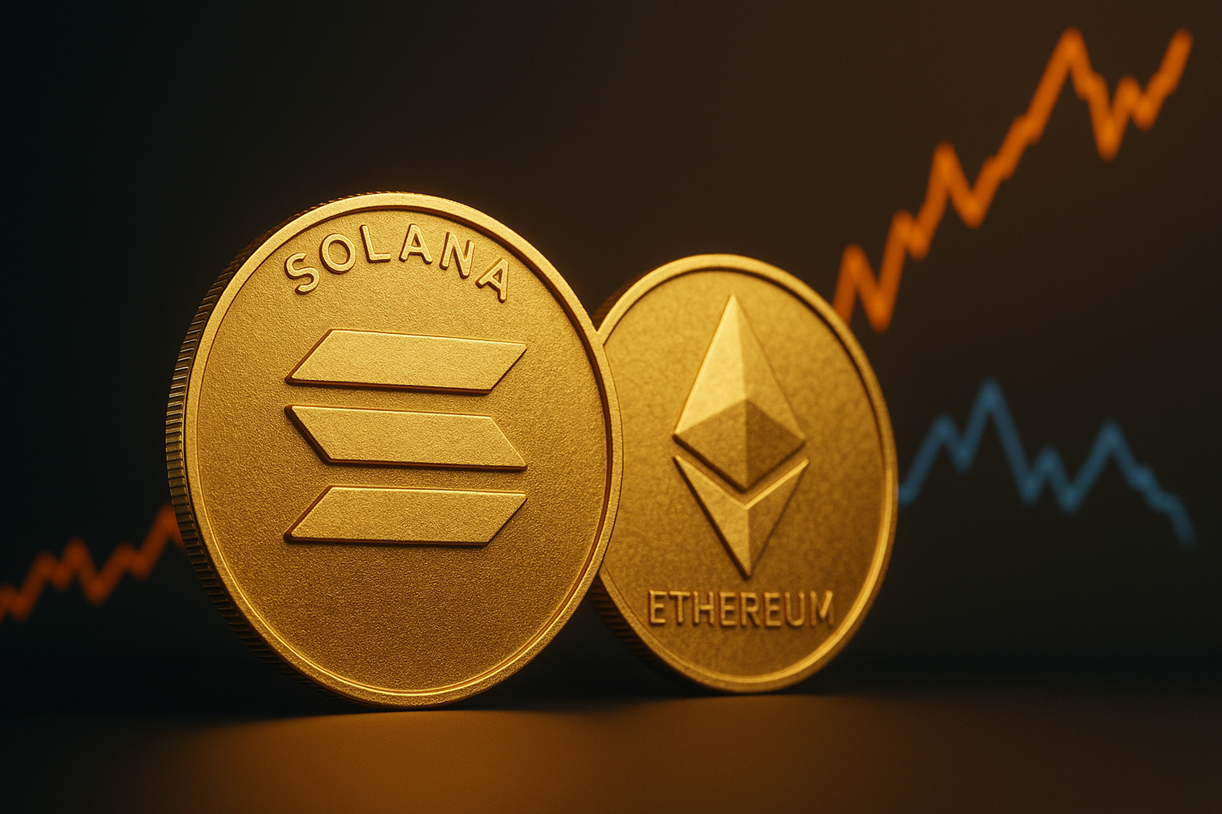Reason to belief
Strict editorial coverage that focuses on accuracy, relevance, and impartiality
Created by business specialists and meticulously reviewed
The highest requirements in reporting and publishing
Strict editorial coverage that focuses on accuracy, relevance, and impartiality
Morbi pretium leo et nisl aliquam mollis. Quisque arcu lorem, ultricies quis pellentesque nec, ullamcorper eu odio.
An X put up by Bonk core contributor Nom (@TheOnlyNom) argues {that a} new wave of Digital Asset Treasury (DAT) autos geared toward SOL may transfer value greater than comparable Bitcoin or Ether treasuries—due to Solana’s smaller market cap, heavy staking that suppresses instantly obtainable float, and the flexibility for treasuries to purchase discounted or locked tokens earlier than they ever contact the open market.
Why Solana DATs Could Move Price 10x Faster Than ETH
“SOL DATs might be extra environment friendly at accumulating at present buying and selling provide (which is completely different than circulating provide) in comparison with ETH or BTC DATs,” Nom wrote, including that “the latest bulletins of $2.5b in SOL DATs must be checked out like a $30b elevate for ETH or $91b for BTC.”
Nom opens with disclosures and caveats moderately than value calls. “I’m not going to argue whether or not inflation is sweet or dangerous, I’ve already spent sufficient time speaking on that and sit up for the adjustments,” he wrote. He additionally underscores his personal positioning and bias: “I’m a spot SOL, staked SOL, and locked SOL holder (because of an SPV on the property SOL) … I might additionally like tokens I personal to go up in worth—so a flat token value is dangerous in my standpoint.”
Related Reading
On the overhang from the FTX chapter property, Nom contends that the danger is shrinking quick even when it nonetheless looms within the narrative. “At the time of chapter, FTX’s property held 41m SOL tokens … with the bulk going to the oldsters at Galaxy and Pantera with strike costs of roughly $64 and $102 … that is at present massively within the cash at Solana’s present ~$190 price ticket,” he wrote.
Based on his studying of staking accounts and vesting schedules, Nom estimates the “‘Estate SOL’ is at present at about 5 million models remaining to be unlocked, or about $1b notional.” He units that in opposition to broader unlocks: “From the nice people over at 4shpool (gelato.sh) there’s about 21m [units] of Solana remaining to unlock till 2028, or ~$4b notional at present pricing … ‘Estate SOL’ is ~1/4 of all remaining SOL to be unlocked.”
The thread’s central mechanism is stream versus float. Nom argues that issuance plus unlocks create persistent promote stress except matched by price-insensitive consumers. “This issues for one particular quantity that we have to give attention to, which is the quantity of SOL hitting the market every day,” he wrote.
“If you give somebody tokens free of charge (staking inflation/unlocks) or at a reduction (FTX SOL) — you’ll be able to count on some % of individuals to promote. I assume 100% of this inflation of 37.5m SOL within the subsequent 12 months to be offered.” That units a excessive bar for demand: “In order to offset 37.5m SOL a 12 months at $200 SOL … you want ~$7.5b/12 months in inflows, or ~$20.5m per day.”
The Differences Between SOL And ETH
Crucially, he argues, DATs can meet that bar extra effectively in the event that they accumulate outdoors the open market. “If the DATs can extra effectively purchase SOL at a reduction from both the property SOL, or different locked SOL areas, that improves the effectivity of the inflows,” he wrote.
“Raising $400m to purchase SOL at a 5% low cost is equal to $420m in inflows, which is healthier than $400m in inflows—the one query is how do you equate the time worth of shopping for SOL off the market right now, vs eradicating future gross sales tomorrow.”
He provides that, on his numbers, issuance dominates the availability image: “Our inflation over the subsequent 3 years is larger than the unlocks (EOY 2028 as finish of lock schedules) … and the FTX SOL is barely 1 / 4 of the remaining unlocks—so the DATs shopping for the property SOL moderately than the market will not be a sensible concern.”
Related Reading
Nom insists the distinction between “buying and selling provide” and headline “circulating provide” is what makes SOL particularly delicate to regular consumers. “Circulating provide is NOT equal to quantity obtainable in the marketplace, particularly for staked belongings. You can’t purchase staked SOL, however you should buy LSTs,” he wrote. Citing present snapshots, he notes, “Solana has 384m of its 608m SOL staked at present, or 63.1% off the market. LSTs account for 33.5m SOL, so let’s put that again as provide available for purchase and spherical it to 350m/508m off the market, or 57.5% off the market and unavailable for buy (no less than with a 2 day lag).” By his math, that thinner rapid float means every new greenback has extra value affect than on chains with decrease staking penetration.
Valuation magnifies the impact, he says. “Solana is at a a lot decrease valuation than ETH or BTC … a greenback spent on a SOL DAT is like $5 on an ETH DAT or $22 on a BTC DAT when taking a look at relative valuations.” Adjusting for staked versus readily tradable provide, he pushes the comparability additional: “When you issue within the circulating provide quantities with staking, that’s nearer to 11x for ETH effectivity or 36x for BTC effectivity.”
He additionally weaves within the function of ETFs and company autos alongside treasuries. “SSK is doing a few of the work at roughly $2m/day in inflows since launch, nevertheless the inflation schedule wants 10x inflows — and this may doubtless include additional ETF approvals,” he wrote, arguing that DATs have a flywheel impact: “These DATs take provide off the market, they earn tokens primarily based on staking yield … and so they make subsequent buys by autos like ETFs more practical at transferring the market.” On sector management, he’s blunt in regards to the want for a standard-bearer: “SOL DATs want a Michael Saylor or a Tom Lee, narrative is the secret.”
His abstract distills the thesis to some traces: “Right now lower than 1% of provide is beneath SOL DAT administration, this may doubtless shift to three% with the three newly introduced autos, and 5% with deliberate future autos.” “Current ETF inflows will not be enough,” he added, “nevertheless bigger autos must be authorised by begin of This autumn and SOL stays a contender for institutional bid.”
Solana Treasury Boom In The Making
Notably, Nom’s framing arrives amid a cascade of latest autos. On Aug. 25–26, Galaxy Digital, Multicoin Capital and Jump Crypto are in talks to lift roughly $1 billion to construct a publicly traded Solana treasury firm, with Cantor Fitzgerald as lead banker. Separately, Pantera Capital is weighing a plan to lift as much as $1.25 billion to transform a Nasdaq-listed agency into “Solana Co.,” a devoted SOL treasury car.
Meanwhile, Nasdaq-listed Sharps Technology introduced a $400 million non-public placement explicitly to determine what it calls the most important company Solana treasury up to now. Together, these offers sketch out no less than $2.5–$3.0 billion of potential new institutional demand pointed squarely at SOL.
At press time, SOL traded at $204.

Featured picture created with DALL.E, chart from TradingView.com









